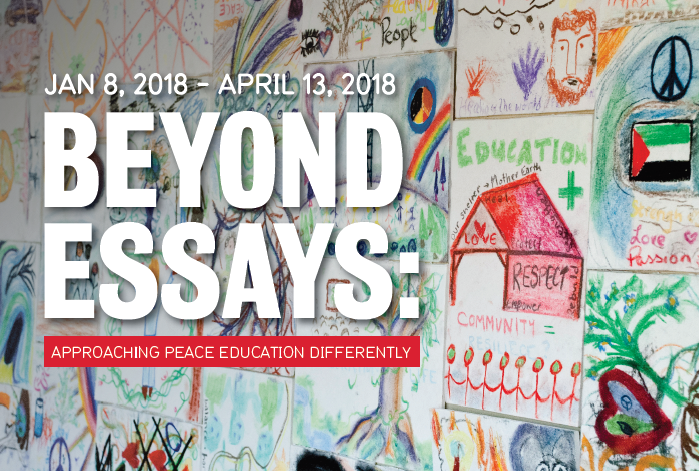
Since its inception 40 years ago, the Peace and Conflict Studies Program (PACS) at the University of Waterloo has remained a leader in peace education. Through its innovative approach to learning, the PACS program creates the opportunity for students to express their engagement with peace in diverse and powerful ways.
On January 8th, in celebration of the PACS program’s 40th anniversary, the Grebel Gallery opened a brand new exhibit in partnership with PACS, “Beyond Essays: Approaching peace education differently”. Through this exhibit, we are celebrating many of the PACS students who have chosen to express their research findings through art. In doing so, we are celebrating the PACS department’s inclusive and creative approach to teaching, and are elevating the CPA’s strategic commitment to peace through artistic expression.
The arts-based pieces featured in the exhibit highlight a wide range of topics, from restorative justice, to religious conflict and violence, to social issues situated right here in the Waterloo Region. The diverse mediums used include paintings, photography, quilts, sculptures, and more, and demonstrate the PACS program’s inventive and well-rounded approach to peace education. At its core, the program endeavours to educate students toward developing a “moral imagination” – a concept coined by peace scholar John Paul Lederach. According to Lederach, the practice of building peace is a creative act – as much an art as a skill – as it requires imagining a world that does not yet exist amidst an in-depth understanding of that world’s current shortcomings.
In this spirit, the PACS program encourages students to engage with peace education in non-traditional ways, like exploring peace and justice through artistic expression. As Rachel Reist from the PACS department stated,
“Arts can touch you in a way that words can’t. It’s hard to convey the depth of knowledge in an essay that you can convey in art. By having an option for students to do arts-based assignments, it allows them to come to the classroom in their full self, and it allows the receiver of their work to access their work in a different way.”
One of the many pieces displayed in the gallery is “Piecing for Peace”, created by a student for PACS 101, “Peace is Everybody’s Business”. This student combined her love for quilting and passion for peace to make a quilt which conveys that, although everyone connects to it in different ways, people from nations around the world and all walks of life want to be a part of peace. Being part of an online quilting community, this PACS student asked people to send in quilt squares that depicted what peace means to them. In return, she received dozens of quilt squares from across the globe, accompanied by letters from quilters who shared stories about their journeys with peace, and the role quilting plays in that relationship.
The stories people shared with the PACS student through their letters speak volumes about the variety of ways people connect with peace. From finding peace and healing through quilting, to using quilting as a tool to promote peace, the varied yet influential presence of peacebuilding is represented in each story. The quilt serves as a reminder that even the seemingly little ways of approaching peace can have a profound impact. As one of the quilters who wrote to the student noted,
“Sewing, quilting included, is a beautiful pursuit that is lifting some of the most vulnerable people on earth out of desperate situations and teaching them that they can stand with dignity”.
Please join us for the exhibit reception on Thursday January 18th, 2018 at 4pm in the Grebel Gallery to celebrate the new exhibit, “Beyond Essays: Approaching peace education differently”. Please let us know you’re coming by registering for the event.